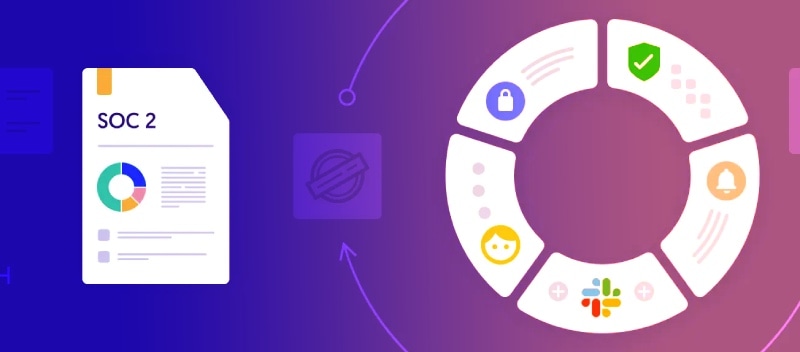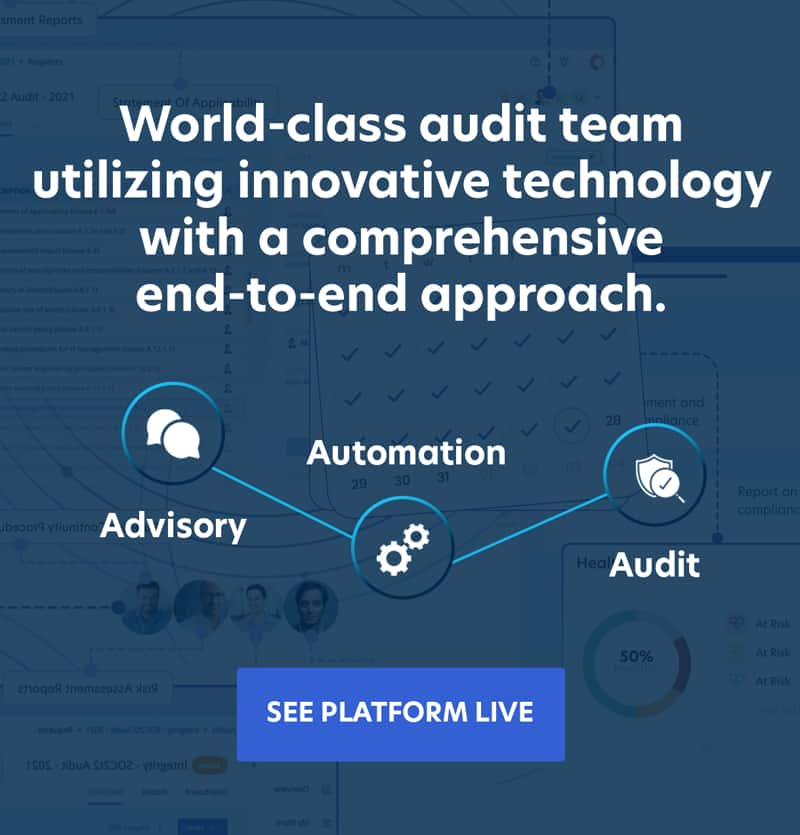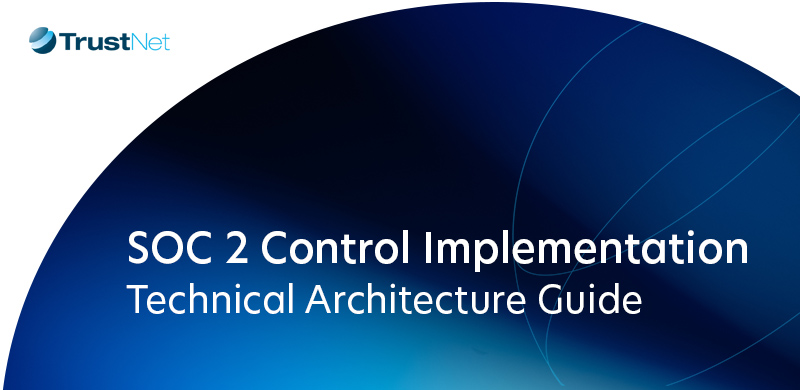Blog SOC 2 Report Example
SOC 2 Report Example

SOC 2 reports are essential for any organization that handles customer data, ensuring that your systems are secure, available, and private. Essentially, a SOC 2 report gives your customers peace of mind, knowing that their information is in safe hands.
But why do these reports matter so much? It’s all about trust. An independent service auditor assessment validates your efforts to protect data and shows clients that you take security seriously. This not only helps in building stronger relationships but also sets you apart in a competitive market. So, let’s explore how SOC 2 reports can be a game-changer for your business.
Understanding the SOC 2 Audit Process
The foundation of SOC 2 compliance is comprised of five fundamental “trust service principles,” namely security, availability, processing integrity, confidentiality, and privacy.
Security. Information and systems are protected against unauthorized access, unauthorized disclosure of information, and damage to systems that could compromise the availability, integrity, confidentiality, and privacy of information or systems and affect the entity’s ability to achieve its objectives.
Security refers to the protection of:
i. information during its collection or creation, use, processing, transmission, and storage, and
ii. systems that use electronic information to process, transmit, transfer, and store information to enable the entity to meet its objectives. Controls over security prevent or detect the breakdown and circumvention of segregation of duties, system failure, incorrect processing, theft or other unauthorized removal of information or system resources, misuse of software, and improper access to or use of, alteration, destruction, or disclosure of information.
Availability. Information and systems are available for operation and use to meet the entity’s objectives.
Processing Integrity. System processing is complete, valid, accurate, timely, and authorized to meet the entity’s objectives.
Confidentiality. Information designated as confidential is protected to meet the entity’s objectives. Confidentiality addresses the entity’s ability to protect information designated as confidential from its collection or creation through its final disposition and removal from the entity’s control in accordance with management’s objectives.
Privacy. Personal information is collected, used, retained, disclosed, and disposed of to meet the entity’s objectives.
Types of SOC Reports: Type I and Type II
– Type I: This report describes a service organization’s systems and whether they are suitably designed to meet relevant trust principles at a specific point in time.
– Type II: This report goes a step further. It not only includes the description of the system but also assesses its operational effectiveness over a period of time, usually six months.
Role of the Service Auditor and AICPA Standards
The service auditor—usually a Certified Public Accountant (CPA)—plays a crucial role in the SOC 2 audit. They conduct the examination following standards set by the American Institute of CPAs (AICPA). Their job is to ensure that your systems meet the specified criteria and that all controls are implemented effectively.
For more about our SOC 2 compliance services, Click Here
Anatomy of a SOC 2 Report
The SOC 2 standard outlines each of the elements that make up the SOC 2 report. The following sections are among (but not restricted to) them:
-
- Report from the auditor
- Management assertion
- System description
- Tests of controls
- Other information
An introduction including broad details about the audited company is part of a SOC 2 report. Furthermore, it outlines the sequence of procedures that were followed during the testing process and how long it took.
In addition, a statement regarding the auditor’s assessment of the service provider’s controls needs to be provided. A few suggestions for enhancing the organization’s security protocols are included in the report, if needed.
Diving into the Example SOC 2 Report
Let’s dive into what an actual SOC 2 report looks like.
Section One – Independent Service Auditor’s Report
- This contains the scope of the report, service organization’s responsibilities, service auditor’s responsibilities, inherent limitations, opinion, description of test of controls and the report’s restricted use.
Section Two – Management Assertion
- This is a management assertion regarding the services and systems throughout the period.
Section Three – Description of Services and Systems
- This includes company overview and background, type of services provided, principal service commitments and system requirements, components of the system (infrastructure, software, people, data, policies and procedures), relevant aspects of the control environment, risk assessment process, information and communication, monitoring activities, and control activities.
Section Four – Service Auditor’s Description of Test of Controls and Results Thereof
- This contains an overview of control objectives, related controls and test of design effectiveness.
By understanding these sections, you’ll get a clear picture of how your organization measures up in terms of security, availability, processing integrity, confidentiality, and privacy.
Evaluating Security Posture and Controls
When it comes to security controls, these are the defensive measures you have in place to protect your data and systems. Some of the key areas covered include:
-
- Access Controls: Who has access to what? Ensuring appropriate access levels for the appropriate individuals is crucial.
-
- Change Management: How do you handle changes to your systems and processes? This ensures there’s no disruption or unintended consequences.
-
- Incident Response: What’s your plan when things go wrong? Effective incident response practices help you quickly contain and mitigate any issues.
Confidentiality, Integrity, and Processing Integrity
- Confidentiality: Are you protecting sensitive information from unauthorized access? This could involve encryption, access controls, and other protective measures.
- Integrity: Is the information accurate and reliable? Ensuring data integrity means it hasn’t been altered or tampered with.
- Processing Integrity: Are your systems processing data correctly and completely? This involves checks and balances to ensure the data processing pipeline is functioning properly.
Subservice Organization Controls and Other Systems Information
Third-party vendors’ (subservice organizations) controls are just as important.
- Subservice Organization Controls: Ensure these vendors are also meeting SOC 2 standards. It’s about extending your security posture to include their practices too.
- Other Systems Information: This includes any additional details about your systems that might impact security, such as network configurations, software versions, and more.
Leveraging SOC 2 for Compliance Automation
With a solid understanding of SOC 2 reports and your security posture, let’s talk about how you can leverage this to streamline compliance through automation.
Mapping SOC 2 to Security Standards and Frameworks
One of the best ways to make SOC 2 work for you is by mapping it to other security standards and frameworks. This is a “compliance map” that aligns with multiple requirements:
-
- HIPAA (Health Insurance Portability and Accountability Act): Aligning SOC 2 controls with HIPAA helps ensure that your security measures meet healthcare industry regulations for protecting patient information.
-
- ISO/IEC 27001: Mapping SOC 2 to this international standard for information security management systems (ISMS) provides a global perspective.
-
- GDPR (General Data Protection Regulation): Ensuring that your SOC 2 controls also meet data privacy laws in the EU.
The standards mentioned are just examples of the standards. There are other standards that can be mapped with SOC.
TrustNet’s compliance management solution, Ghostwatch, is now extending its capabilities by integrating control mapping across various projects. Similarly, HyperProof offers the feature to align these controls with different standards, enhancing the overall compliance process.
Continuous Monitoring and Documentation
Compliance isn’t a one-and-done deal; it’s an ongoing process. Continuous monitoring and proper documentation are key to maintaining compliance year-round.
- Continuous Monitoring: Implement tools and processes to keep an eye on your controls continuously. This helps you quickly spot and address any issues.
- Documentation: Keep detailed records of all your compliance activities. This makes it easier to prove compliance during audits and can help identify areas for improvement.
Integrating SOC 2 with Compliance Automation Platforms
Finally, leveraging compliance automation platforms can take a lot of the manual work out of the process.
- Automation Platforms: These tools can help automate data collection, control monitoring, and reporting.
- Integration: These platforms often integrate seamlessly with your existing systems, making it easier to manage everything from one place.
- Efficiency: Automation not only saves time but also reduces the risk of human error, ensuring more accurate compliance efforts.
Preparing for the Next Audit
As you gear up for your next SOC 2 audit, it’s crucial to address past findings and keep your security measures in top shape.
Addressing Audit Findings and Recommendations
Take a good look at your previous audit findings.
-
- Action Plans: Develop clear action plans to address any identified deficiencies.
-
- Follow-Up: Regularly check in on these plans to ensure they’re being implemented effectively.
Maintaining a Robust Security Infrastructure
Keeping your security infrastructure robust is an ongoing task.
-
- Regular Updates: Ensure your software, hardware, and policies are always up-to-date.
-
- Training: Regularly train your team on the latest security protocols and best practices.
Ongoing Security Insights and Improvements
Lastly, continuous improvement is key to staying ahead.
-
- Monitor Trends: Keep an eye on the latest security trends and threats.
-
- Feedback Loops: Utilize feedback from audits and real-world incidents to continuously improve your security posture.
By addressing past findings, maintaining a strong security infrastructure, and staying proactive with ongoing improvements, you’ll be well-prepared for your next SOC 2 audit.
Enhancing Trust with SOC 2 Compliance
Embarking on the SOC 2 audit journey can seem daunting, but breaking it down step by step—from understanding the trust criteria to leveraging compliance automation—makes it manageable and sets you up for success.
SOC 2 isn’t just a checkbox; it’s a comprehensive framework that enhances your information security posture and builds trust with your customers. Furthermore, regular SOC 2 audits are crucial for maintaining compliance and continuously improving your security measures.
At TrustNet, SOC 2 compliance services are our area of expertise. TrustNet is committed to your business’ security and compliance at peak levels.
Ensure your data security and build client trust with TrustNet’s expert SOC 2 compliance services. Talk to our Experts today.




